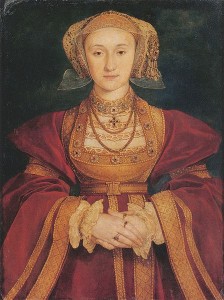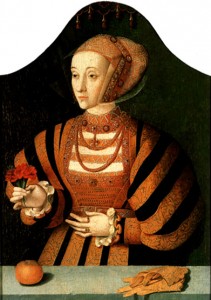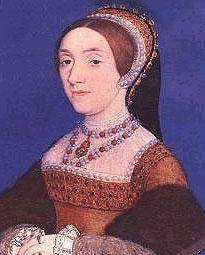 July 1540 was a busy month for King Henry VIII, he divorced his fourth wife, Anne of Cleves, and married his fifth wife, Catherine Howard. Henry and Anne had been married just 6 months and the marriage had never been consummated, so what on earth went wrong?
July 1540 was a busy month for King Henry VIII, he divorced his fourth wife, Anne of Cleves, and married his fifth wife, Catherine Howard. Henry and Anne had been married just 6 months and the marriage had never been consummated, so what on earth went wrong?
An Anglo-German Alliance
Anne of Cleves had been chosen as a suitable bride for Henry VIII because Thomas Cromwell, Henry’s chief minister, saw the benefit in building links with the Schmalkaldic League at a time when Francis I of France and Charles V, Holy Roman Emperor, were best buddies. England needed a strong ally and Anne of Cleves was related to John Frederick of Saxony (he was her brother-in-law) and was the daughter of the Duke of Cleves. Elizabeth Norton points out that she was in fact “the most eligible bride that the League had” and John Frederick was willing to consider an alliance with England.
Before Henry VIII would consider marrying Anne, he wanted to know what she looked like. Unfortunately the German painter was ill but Henry’s ambassador, Christopher Mont, reported that “everyone praises the lady’s beauty, both of face and body. One said she excelled the Duchess [of Milan] as the golden sun did the silver moon”. Henry was encouraged but still wanted a portrait just to make sure. He sent some more ambassadors, Wotton and Berde, to Cleves to get a portrait of Anne and although they were offered a picture of her and her sister by the vice-chancellor of Cleves, they were unable to comment on its accuracy because Anne kept her face covered in their presence. In the summer of 1539, Henry VIII sent Hans Holbein, his court painter to Cleves to paint Anne and her younger sister, Amelia. Holbein followed his patron’s instructions and Wotton reported that Holbein “hathe expressyd theyr imaiges verye lyvelye” and those who had seen Anne and Hobein’s portrait agreed that it was a good likeness. Henry was happy and negotiations continued.
A Disastrous Meeting
After the marriage treaty had been agreed, Anne left her homeland of Cleves to travel to England to marry Henry. She landed at Deal, in Kent, on the 27th December 1539 and was informed that she would be meeting her future husband at Greenwich Palace in a few days time. However, Henry had other ideas. He was excited about meeting Anne, whose portrait he had fallen in love with, and he loved the chivalric tradition of meeting his bride in disguise. According to tradition, the love between them would mean that she would see right through his disguise and recognise him as her beloved husband. Elizabeth Norton points out that Henry forgot the story of the disastrous meeting between his great-uncle, Henry VI, and his bride, Margaret of Anjou, and just pressed on with the idea.
Henry VIII and his attendant, Sir Anthony Browne, arrived at Rochester to see Anne and Henry ordered Browne to tell Anne that they had brought her a New Year’s gift from the king. After Browne had informed Anne of this, Henry, in disguise, entered the room to show Anne the gift he’d brought her. Anne was watching bull-baiting out of the window and did not pay any attention to this lowly servant. Shocked at Anne’s disinterest in him, Henry pulled the stunned young woman towards her and attempted to kiss her. Poor Anne! She must have been shocked and upset from this overly familiar greeting from a stranger and obviously did not respond to the King’s advances. Poor Henry too. His dreams of romance and chivalry came crashing down and he was completely humiliated. This disastrous meeting made Henry take an instant dislike to his bride.
 A Flanders Mare
A Flanders Mare
To cover up his disappointment and humiliation, Henry VIII stated that he did not like his bride. There has been much controversy over Anne’s appearance, whether she was more of a “Flanders Mare” than the “golden sun” that Henry had been expecting. However, Elizabeth Norton points out that Henry VIII did not punish Hans Holbein for his depiction of Anne of Cleves and continued to use him right up until Holbein’s death. This continuing confidence in Holbein’s abilities suggest that the portrait was a true likeness of Anne and her portrait shows her to be just as pretty, if not prettier than the likes of Jane Seymour and Catherine Howard. Also, Henry’s ambassadors had not mentioned that Henry’s prospective bride was ugly and although the French ambassador, Marillac, described Anne as “not so young as was expected, nor so beautiful as everyone affirmed”, he was quick to point out that she had “vivacity of wit” and was the most beautiful of her party of women. I am inclined to think that Henry’s distaste was caused by his own embarrassment and humiliation, and perhaps the realisation that he was not a “catch” himself anymore, rather than any fault with Anne’s appearance.
The Unhappy Marriage
Henry had made up his mind. He did not like Anne of Cleves and he did not want to marry her. Unfortunately, there was nothing that could be done. There was a marriage treaty which just could not be broken without upsetting Anne’s brother, now the Duke of Cleves, and forcing him into an alliance with either France or the Emperor, or both. Although it was suggested that Anne’s former betrothal to Francis of Lorraine could be used to prevent the marriage, Anne swore that she was free from any pre-contract – the marriage had to go ahead.
Henry VIII married Anne of Cleves on the 6th January 1540 at the Palace of Placentia in Greenwich. Archbishop Thomas Cranmer performed the ceremony and everything went smoothly. The wedding night was a different matter! We obviously do not know exactly what happened but the marriage was not consummated. Henry declared to Cromwell the next day “Surlye my lorde as ye know I lyked her befor not well but now I lyke her moche worse” and went on to say that he doubted her virginity. When he spoke to Anthony Denny, he said that “he could never in her company be provoked and stered to know her carnally”. Was Anne being blamed for Henry’s impotency? Was Henry so embarrassed that he could not perform his husbandly duty that he needed to pass the blame onto Anne? Perhaps so. He did, however, keep visiting his Queen at night and threw a grand pageant in her honour, but it was no good, there was no real, personal relationship between them. The marriage had ended before it had even begun.
The Divorce
Although Anne of Cleves quickly became popular with the English people, and the public perception was that the marriage was happy, Henry VIII was not a happy man and wanted someone to pay for his predicament. Thomas Cromwell, the man who had orchestrated the marriage, was the man to pay the price. He had enemies in the King’s Council and the failure of the Cleves marriage was just the ammunition that men like Gardiner and Norfolk needed to get rid of him. On the 10th June 1540, at a council meeting, Thomas Cromwell was arrested for treason and subsequently executed on the 28th July 1540.
In the meantime, Anne of Cleves had got wind that all was not well. She had been removed from court and sent to Richmond Palace and there were rumours that her husband was going to replace her with one of her ladies in waiting. Knowing what had happened to Anne Boleyn, Anne of Cleves must have been a very worried young woman.
While Anne was at Richmond, Gardiner was carrying out investigations into Anne’s precontract with Francis of Lorraine, in the hope that it would help the King wriggle out of his unhappy marriage. On the 6th July 1540, a messenger was sent to Anne to inform her of her husband’s concerns over their marriage and to obain her consent for a church court to investigate. Anne was understandably terrified, particularly as the messenger arrived in the middle of the night. She must have feared that she was going to be taken to the tower and put to death like Anne Boleyn! She consented to the investigation, what choice did she have? Anne’s brother’s ambassador, Carl Harst, was furious at the way Anne was being treated and refused to be involved in the investigation. He was, however, reassured by members of the King’s council that Anne would be treated well.
This must have been an incredibly traumatic time for Anne, who only knew a little English and who was in a foreign country. While Henry pretended that he was only having the marriage investigated because his council were worried about the succession, Anne was left to await her fate. On the 7th July 1540 a convocation of clergy agreed that “the king and Anne of Cleves were no wise bound by the marriage solemnised between them, and it was decreed to send letters testimonial of this to the king.” Anne knew nothing of this meeting, and neither did Harst, they were deliberately kept in the dark. The invalidity of the marriage was proven by three pieces of evidence: 1) The betrothal between Anne and Francis of Lorraine, 2) Henry’s lack of consent to the marriage and 3) Lack of consummation – Henry declared that “I never for love to the woman consented to marry; nor yet if she brought maidenhead with her, took any from her by true carnal copulation”.

Messengers were then sent to Anne to get her to agree to the annulment of the marriage. Apparently, Anne was so frightened that she fainted. She feared what would happen if she resisted the King’s request and so wrote to the King confirming that she accepted the annulment and signing herself “Anne, the daughter of Cleves”, rather than “Anne, the Queen”. Henry must have been delighted that she was so submissive and her wrote back to her, addressing her as his “right dear and right entirely beloved sister”, thanking her and informing her that he was intending to endow her with £4000 per year and houses at Richmond and “Blechinglegh” (Bletchingley). Anne was rewarded handsomely for her acceptance of the situation, also receiving jewels, plate, hangings, furniture, a house in Lewes and also Hever Castle, the former Boleyn family home.
Just a few weeks after the annulment and on the same day as Cromwell was executed, the 28th July 1540, King Henry VIII married Catherine Howard. It is evident that Henry did care for Anne as he did take the time to visit her and inform her of his marriage and the two of them dined together. Elizabeth Norton writes of Anne of Cleves:-
“Despite her acquiescence, Anne always believed herself to be the legitimate wife of the king and the true queen. In spite of this she was, first and foremost, a survivor and , if the price of that survival was a denial of her true status in exchange for a life of opulent retirement, she was prepared to play along, even if that meant accepting a new lower status beside her former maid, Queen Catherine Howard.”
Anne was a pragmatist and made the best of her situation. She went on to have a good relationship with Henry, so much so that she even thought that he’d remarry her after Catherine’s fall, and his children, and outlived the King and all of his other wives, dying on the 15th July 1557 aged 41. Her life was far from trouble-free but at least she survived marriage to the infamous Henry VIII.